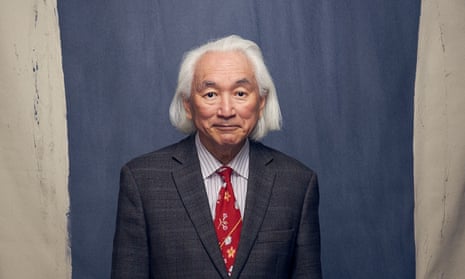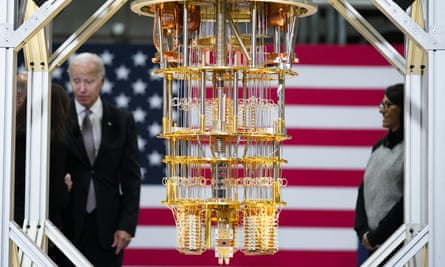Physicist Michio Kaku: ‘We could unravel the secrets of the universe’

“Have you been feeling anxious about technology lately? If so, you’re in good company. The United Nations has urged all governments to implement a set of rules designed to rein in artificial intelligence. An open letter, signed by such luminaries as Yuval Noah Harari and Elon Musk, called for research into the most advanced AI to be paused and measures taken to ensure it remains “safe … trustworthy, and loyal”. These pangs followed the launch last year of ChatGPT, a chatbot that can write you an essay on Milton as easily as it can generate a recipe for everything you happen to have in your cupboard that evening.
But what if the computers used to develop AI were replaced by ones able to make calculations not millions, but trillions of times faster? What if tasks that might take thousands of years to perform on today’s devices could be completed in a matter of seconds? Well, that’s precisely the future that physicist Michio Kaku is predicting. He believes we are about to leave the digital age behind for a quantum era that will bring unimaginable scientific and societal change. Computers will no longer use transistors, but subatomic particles, to make calculations, unleashing incredible processing power. Another physicist has likened it to putting “a rocket engine in your car”. How are you feeling now?
Kaku seems pretty relaxed about it all – some might say boosterish. He talks to me via Zoom from his apartment on Manhattan’s Upper West Side. Seventy-six and retired from research, he still teaches at the City University of New York where he is professor of theoretical physics and gets to do the fun stuff. A fan of Isaac Asimov, he tells me that he’s currently teaching a course on the physics of science fiction. “I talk about what is known and not known about time travel, space warps, the multiverse, all the things you see in Marvel Comics, I break it down.” His website describes him as a “futurist and populariser of science” and his new book, Quantum Supremacy, sketches out all the promise of quantum computing and very little of the downside. Though he has the long white hair of the stereotypical mad scientist, it is swept back elegantly. He speaks at the pace of a practised lecturer, with the occasional outbreak of mild bemusement pitching his voice a little higher.
Kaku has a simple explanation for the doom-mongering around ChatGPT: “Journalists are hyperventilating about chatbots … because they see that their job is on the line. Many jobs have been on the line historically, but no one really said much about them. Now, journalists are right there in the crosshairs.” This is a somewhat partial view – a report by Goldman Sachs recently estimated that 300m jobs are at risk of automation as a result of AI. Kaku does admit that we might see “sentient machines” emerging from laboratories but reckons that could take another hundred years or so. In the meantime, he thinks there’s a lot to feel good about.
The rocket engine of quantum computing will, Kaku says, completely transform research in chemistry, biology and physics, with all sorts of knock-on effects. Among other things, it will enable us to take CO2 out of the atmosphere and turn it into fuel, with the waste products captured and used again – so-called carbon recycling. It will help us extract nitrogen from the air without the high temperatures and pressures that mean fertiliser production currently accounts for 2% of the energy used on Earth, leading to a new green revolution. It will allow us to create super-efficient batteries to help renewables go further (today’s lithium-ion batteries only carry about 1% of the energy stored in gasoline). It will solve the design and engineering challenges currently stopping us from generating cheap, abundant power via nuclear fusion. And it will lead to radically effective treatments for cancer, Alzheimer’s and Parkinson’s diseases, alongside a host of others.

How? The main thing to understand is that quantum computers can make calculations much, much faster than digital ones. They do this using qubits, the quantum equivalent of bits – the zeros and ones that convey information in a conventional computer. Whereas bits are stored as electrical charges in transistors etched on to silicon chips, qubits are represented by properties of particles, for example, the angular momentum of an electron. Qubits’ superior firepower comes about because the laws of classical physics do not apply in the strange subatomic world, allowing them to take any value between zero and one, and enabling a mysterious process called quantum entanglement, which Einstein famously called spukhafte Fernwirkung or “spooky action at a distance”. Kaku makes valiant efforts to explain these mechanisms in his book, but it’s essentially impossible for a layperson to fully grasp. As the science communicator Sabine Hossenfelder puts it in one of her wildly popular YouTube videos on the subject: “When we write about quantum mechanics, we’re faced with the task of converting mathematical expressions into language. And regardless of which language we use, English, German, Chinese or whatever, our language didn’t evolve to describe quantum behaviour.”
What we’re left with are analogies of varying helpfulness, for example the toy trains with compasses on them and mice in mazes that Kaku invokes to explain such complex ideas as superposition and path integrals. Beyond these, there is one important takeaway: reality is quantum, and so quantum computers can simulate it in a way that digital ones struggle to. “Mother Nature does not compute digitally,” he tells me. “Quantum computers should [be able to] unravel the secrets of life, the secrets of the universe, the secrets of matter, because the language of nature is the quantum principle.” If you want to know precisely how photosynthesis works (still a mystery to modern science), or how one protein interacts with another in the human body, you will be able to use the “virtual lab” of a quantum computer to model it precisely. Designing medicines to interrupt biological processes gone awry, like the proliferation of cancer cells or the misfolding of proteins in Alzheimer’s disease, could become much easier. Kaku even reckons that the riddle of ageing will be unravelled so that we can arrest it – one of the chapters in his book is called simply “Immortality”.
At this stage, it’s worth introducing an important caveat. Quantum computers are very, very hard to make. Because they rely on tiny particles that are extremely sensitive to any kind of disturbance, most can only run at temperatures close to absolute zero, where everything slows down and there’s minimal environmental “noise”. That is, as you would expect, quite difficult to arrange. So far, the most advanced quantum computer in the world, IBM’s Osprey, has 433 qubits. This might not sound like much, but as the company points out “the number of classical bits that would be necessary to represent a state on the Osprey processor far exceeds the total number of atoms in the known universe”. What they don’t say is that it only works for about 70 to 80 millionths of a second before being overwhelmed by noise. Not only that, but the calculations it can make have very limited applications. As Kaku himself notes: “A workable quantum computer that can solve real-world problems is still many years in the future.” Some physicists, such as Mikhail Dyakonov at the University of Montpellier, believe the technical challenges mean the chances of a quantum computer “that could compete with your laptop” ever being built are pretty much zero.
Kaku brushes this off. He points to the billions of dollars being poured into quantum research – “the Gold Rush is on” he says – and the way intelligence agencies have been warning about the need to get quantum-ready. That’s hardly proof positive they’ll live up to expectations – it could be tulip mania rather than a gold rush. He shrugs: “Life’s a gamble.”
In any case, he’s far from the only true believer. Corporations such as IBM, Google, Microsoft and Intel are investing heavily in the technology, as is the Chinese government, which has developed a 113 qubit computer called Jiuzhang. So, assuming for a moment quantum dreams do become a reality: is it responsible to accentuate the positive, as Kaku does? What about the possibility of these immense capabilities being used for ill?
“Well, that’s the universal law of technology, that [it] can be used for good or evil. When humans discovered the bow and arrow, we could use that to bring down game and feed people in our tribe. But of course, the bow and arrow can also be used against our enemies.”
Advances in physics, in particular, have always raised the prospect of new and more fearsome weapons. But you can’t hold back research as a result: you make the discoveries, then you deal with the consequences. “That’s why we regulate nuclear weapons. Nuclear weapons are a rather simple consequence of Einstein’s E=mc2. And they have to be regulated, because the ‘E’ would be enough to destroy humanity on planet Earth. At some point, we’re going to reach the boundaries of this technology, where it impacts negatively on society. Right now, I can see a lot of benefits.”
In any case, for Kaku, knowledge is power. It’s part of the reason he’s moved from the lab to TV, radio and books. “The whole purpose of writing books for the public is so that [they] can make educated, reasonable, wise decisions about the future of technology. Once technology becomes so complicated that the average person cannot grasp it, then there’s big trouble, because then people with no moral compass will be in charge of the direction of that technology.”
There are other reasons, as well. From an early age, Kaku was, unsurprisingly, a science fiction nut. But he wasn’t content to simply swallow the stories, and wanted to know if they were really possible, whether the laws of physics might verify or contradict them. “And in the science section, there was nothing, absolutely nothing. And I was [also] fascinated by Einstein’s dream of a theory of everything, a unified field theory. Again I found nothing, not a single book, on Einstein’s great dream. And I said to myself, when I grow up, and I become a theoretical physicist, I want to write papers on this subject. But I also want to write for myself as a child, going to the library and being so frustrated that there was nothing for me to read. And that’s what I do.”
Kaku’s parents were among those American citizens of Japanese descent who were interned during the second world war, despite having been born in the country. Like his father, he was raised in Palo Alto, California, the “ground zero” of the tech revolution. The irony isn’t lost on him. “I saw Silicon Valley grow from nothing. When I was a child, it was all alfalfa fields, apple orchards. I used to play in the apple orchards of what is now Apple,” he chuckles. If his predictions about the quantum revolution are correct, it could soon be transformed again. “Silicon Valley could become a rust belt … a junkyard of chips that no one uses any more because they’re too primitive.” Or, more likely, a gleaming new centre of quantum computation, as today’s tech giants scramble to redeploy their immense intellectual and financial capital. Whether Kaku’s quantum revolution lives up to the hype remains to be seen. But if he is right and all that is digital passes into dust, we’re in for one hell of a ride.“
No comments:
Post a Comment
Note: Only a member of this blog may post a comment.